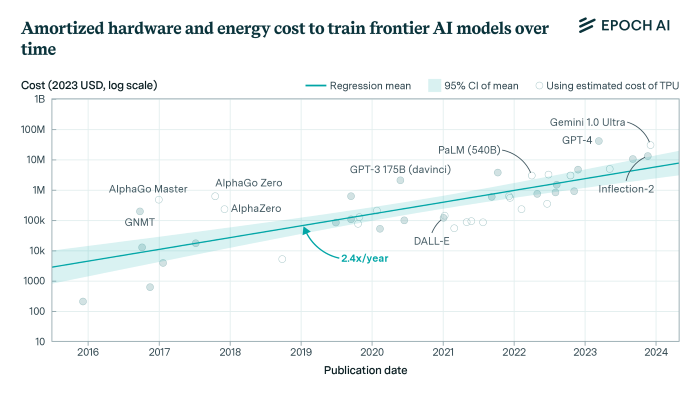The Skyrocketing Costs of Training Frontier AI Models: A C-Suite Primer

In the race to develop increasingly sophisticated artificial intelligence, a new factor is emerging as a potential bottleneck: the astronomical costs associated with training frontier AI models. As we push the boundaries of what AI can do, we're also pushing the limits of what organizations can afford to invest in this cutting-edge technology.
The Exponential Growth of Training Costs
Recent research from Epoch AI has revealed a startling trend: the cost of training frontier AI models has been growing by a factor of 2 to 3 times per year for the past eight years. This exponential growth trajectory suggests that by 2027, the price tag for training the largest AI models could exceed $1 billion.
To put this in perspective, imagine if the cost of developing a new smartphone or a breakthrough drug doubled or tripled every single year. The implications for innovation, market competition, and resource allocation would be profound – and that's exactly the situation we're facing in the AI industry.

Breaking Down the Costs
When we talk about the costs of training AI models, we're not just referring to the electricity bill. The expenses can be broadly categorized into three main areas:
- Hardware (47-67% of total cost): This includes AI accelerator chips (like GPUs or TPUs), servers, and the complex interconnection hardware required to link these components into powerful supercomputers.
- R&D Staff (29-49% of total cost): The brilliant minds behind these AI models don't come cheap. This category includes salaries, benefits, and equity compensation for the teams of researchers and engineers working on model development.
- Energy (2-6% of total cost): While a relatively small percentage of the overall cost, the energy requirements are staggering. For instance, training a model like Google's Gemini Ultra is estimated to require about 35 megawatts of power – enough to supply a small town.
The Implications for Business and Innovation
This rapid escalation in costs has several important implications for the business world:
- Concentration of Power: Only a handful of well-funded organizations can afford to be at the cutting edge of AI development. This could lead to a concentration of AI capabilities among a few tech giants and well-funded startups.
- Investment Challenges: As costs balloon, convincing investors that the economic returns justify the massive expenditures becomes increasingly difficult. This could slow the pace of innovation or lead to a "boom-bust" cycle in AI investment.
- Infrastructure Bottlenecks: The power requirements for these AI supercomputers are pushing the limits of existing infrastructure. Future developments may be constrained not just by cost, but by the ability to physically power and cool these massive systems.
- Shift in Competitive Dynamics: The ability to train frontier AI models may become a key differentiator in multiple industries, potentially reshaping competitive landscapes across sectors.
Looking Ahead: Strategies for Adaptation
Given these trends, what strategies should forward-thinking executives consider?
- Collaborative Approaches: Pooling resources through industry consortiums or public-private partnerships may become increasingly attractive.
- Focus on Efficiency: Investing in research to make AI training more efficient could yield significant competitive advantages.
- Specialized Applications: Rather than competing on the largest, most general models, some organizations may find success in developing highly specialized AI for specific use cases.
- Cloud and API Strategies: For many applications, accessing AI capabilities through cloud services or APIs may be more cost-effective than in-house development.
The path forward in AI development is both exciting and challenging. As costs continue to rise, the ability to strategically invest in and leverage AI capabilities will become an increasingly critical factor in business success. By understanding these trends and their implications, executives can better position their organizations to thrive in an AI-driven future.




